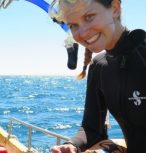DNA reveals the past and future of coral reefs
New DNA techniques are being used to understand how coral reacted to the end of the last ice age in order to better predict how they will cope with current changes to the climate. James Cook Univer

From 2005 to 2022, the main node of the ARC Centre of Excellence for Coral Reef Studies was headquartered at James Cook University in Townsville, Queensland (Australia)








Abstract. Coral reefs are some of the most biodiverse ecosystems on the planet and are extremely important ecologically, economically, socially and scientifically. Spurs and grooves are a common feature of coral reefs worldwide with their distinct finger-like morphology extending down the reef slope at the interface between the reef and the open ocean. Spurs and grooves represent one of the most biodiverse and productive zones of modern reefs. They also act as natural breakwaters, regulating the hydrodynamic energy and nutrients received by reef platforms and thus affecting reef platform geomorphology. However, they are difficult to access and hence few studies have collected quantitative data regarding the morphology, hydrodynamics and reef growth of spur and groove systems. Thus, many questions remain about their formation and evolution. This talk will present a journey through the secret life of spurs and grooves exploring the morphology, hydrodynamics and long term evolution of spur and groove systems in the southern Great Barrier Reef and French Polynesia.
Biography. Stephanie is a coral reef geomorphologist and spatial scientist. She completed her undergraduate degree and honours at JCU in Townsville studying the impacts of harbour infrastructure on reef islands in the Torres Strait. She later completed an International Masters in Geospatial Technologies in Europe with a particular focus on spatial data interoperability. After a few years working in the environmental consulting industry she decided to return to reef research and undertook her PhD at the University of Sydney. Stephanie has just returned to JCU as the lecturer in spatial science on the Townsville campus. She enjoys multidisciplinary research and the opportunity to combine field work with a variety of technologies, to measure, understand, and manage complex natural environments.
New DNA techniques are being used to understand how coral reacted to the end of the last ice age in order to better predict how they will cope with current changes to the climate. James Cook Univer
A new study on the effects of climate change in five tropical countries has found fisheries are in more trouble than agriculture, and poor people are in the most danger. Distinguished Profess
James Cook University researchers have found brightly coloured fish are becoming increasingly rare as coral declines, with the phenomenon likely to get worse in the future. Christopher Hemingson, a
Researchers working with stakeholders in the Great Barrier Reef region have come up with ideas on how groups responsible for looking after the reef can operate more effectively when the next bleaching
Abstract: As marine species adapt to climate change, their heat tolerance will likely be under strong selection. Individual variation in heat tolerance and its heritability underpin the potential fo
Abstract: The Reef Ecology Lab in KAUST’s Red Sea Research Center explores many aspects of movement ecology of marine organisms, ranging from adult migrations to intergenerational larval dispersal
Abstract: Macroalgal meadows are a prominent, yet often maligned component of the tropical seascape. Our work at Ningaloo reef in WA demonstrate that canopy forming macroalgae provide habitat for ad
Abstract: Sharks are generally perceived as strong and fearsome animals. With fossils dating back at least 420 million years, sharks are not only majestic top predators but they also outlived dinosa
Abstract: Connectivity plays a vital role in many ecosystems through its effects on fundamental ecological and evolutionary processes. Its consequences for populations and metapopulations have been
Abstract: Evolution of many eukaryotic organisms is affected by interactions with microbes. Microbial symbioses can ultimately reflect host’s diet, habitat range, and even body shape. However, how
Abstract: The past few years have seen unprecedented coral bleaching and mortality on the Great Barrier Reef (GBR) but the consequences of this on biodiversity are not yet known. This talk will expl